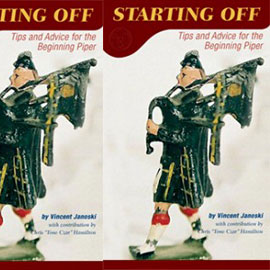Unleashing Your Imaginary Bagpiper
 There is a great quote by Franz Liszt:
There is a great quote by Franz Liszt:
“Think 10 times, play once.”
Franz Liszt was a virtuouso. A musician who amazed even his peers at the time (e.g., Wagner, Shumman) with his musical abilities. So when someone of such prodigious talent utters such a line, take note. It’s the kind of quote that could mean different things on different days. But in the end, it speaks to the value of mental practice.
How many of us wish we had more personal time to practice our music? Are you a bagpiper or drummer who is constantly pressured to find the time in a busy life to schedule regular, consistent rehearsal to learn new music, or practice your current repertoire? Engaging in mental practice sessions is something that can fit into even the busiest of schedules, and give the additional time we crave.
Mental practice is what it suggests: practice in the imagination. It is daydreaming, put simply. But it is directed daydreaming. That is, it is visualizing, or running through physical routines in your mind the way you would perform them. For musicians, this is simply imagining yourself playing or performing your music in the way you desire to hear it, without weaknesses and without any flaws.
For more insight into the idea of mental practice, read a book called Psycho-Cybernetics by Maxwell Maltz. In it, Maltz explains the basis of mental practice, which is the fact that the nervous system cannot tell the difference between a vividly imagined experience, and an actual one. He tells of an experiment where basketball players were divided into two groups. One practiced foul shots every day for an hour, the other laid down and only imagined they were doing fouls shots (successfully, of course). At the end of the experiment, the second group showed as much or more improvement as the first.
There are other experiments, and here’s where it gets interesting. Maltz performed similar experiments with piano music and children. The experiment centered around a single piece of new music. Control groups were given a daily regimen of physical practice and rehearsal, while another group was given minimal amounts of physical rehearsal, while spending regular periods of time imagining themselves playing the piece. In the end, the group who spent most of their time playing the piece in their minds showed equal and sometimes greater aptitude in actual playing of the piece, and developed this aptitude more quickly than the control group.
How many bagpipers complain of difficulty memorizing music, or consider certain tunes too difficult to play? The solution lies in actually imagining “ourselves” playing the piece well, or the way we wish it heard. Kinetic memory or the physical habits that are required to play bagpipes (and drums), normal recall, as well as aural memory, all start in the brain. There are no physical barriers to imagining yourself playing even the most difficult tune flawlessly. You can belt through captivating renditions of “Mrs. MacPherson of Inveran” or “Lament for Patrick Óg MacCrimmon.” Your imaginary piper can do anything! As you get used to the idea of doing the “right” things in your head, you are that much closer to having them emerge in the physical act. Exercising the mind has enormous benefits.
No one needs tips on how to daydream probably, but here are some things you can do to start working in a routine of mental practice for your bagpiping.
- Pick a time where you are not engaged in particularly demanding physical task, but a time that occupies each day the same way. This can be a regular walk for exercise, driving or riding the train to work, taking a shower. Make this your “practice time” for your imaginary piper.
- Use your chosen time to run through your repertoire. If you’re new to this kind of daydreaming, start with tunes you know well, that are almost second nature. Imagine yourself playing the bagpipe, the physical act of blowing, squeezing, and fingering the chanter. Focus on how that feels. Then start the tune or set and run through the whole thing start to finish, at tempo, note-for-note. Try to actually “hear” the tone of your instrument. Try to hear the sound of movements the way you want to play them. Picture your fingers playing certain movements with clean and clear gracings. Lock into subtleties of rhythm and phrasing. For an automatic, or habitual tune, this should come easy, but do this for a while until you get used to forming a strong picture in your head without distraction.
- Once you are used to creating a solid picture of yourself playing, or, if you are already used to this sort of daydreaming, start alternating with other parts of your repertoire. Imagine running through your entire piobaireachd, as if you were in competition, with all the phrasing and feeling the tune deserves. Picture perfect execution, and good timing. Alternate with new tunes you might be working on. Hear them played and recalled perfectly. Imagine playing your march, strathspey & reel sets with all the musical expression and clear technique that should be there.
- After you’ve spent regular time mentally practicing your material, start to use this time to bring other aspects of musicality into your playing. Imagine playing your tune(s) a little differently—a little more emphasis here, a little less there—pick up the tempo or slow down. Try to really hear what the tune might sound like with these alterations. The benefit of playing in your imagination means that there is no pressure—no judge to score you, no instructor to admonish you, and no audience to criticize you.
Learning and playing the Highland bagpipe can be as much about unlocking personal potential as it is about playing music. Muscles take a long time to develop, and physical habits can take ages to take hold before they become natural. The mind is a far superior instrument and will adapt and develop quicker than your body, and it is the mind calling the shots. Including a regimen of mental practice in your musical routine is the fastest way to get results out of the hard physical practice you may already be doing.
-
Nathan
 Pipehacker
Pipehacker








